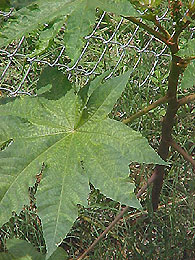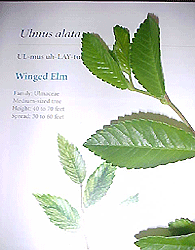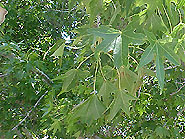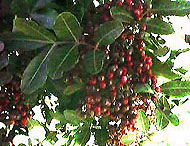Wednesday, June 30, 2004
A little scare
 I had a little scare today. Shortly after we had some soil added to our backyard not too long ago, I noticed a little plant starting to grow. As it grew, I saw that the leaves were fairly large and it looked like a plant that I've seen growing along roads and pond edges. Those plants are about 10-12 feet tall with extremely large leaves and a purplish watery-looking stem. Since I didn't know exactly what it was I decided to let it grow.
I had a little scare today. Shortly after we had some soil added to our backyard not too long ago, I noticed a little plant starting to grow. As it grew, I saw that the leaves were fairly large and it looked like a plant that I've seen growing along roads and pond edges. Those plants are about 10-12 feet tall with extremely large leaves and a purplish watery-looking stem. Since I didn't know exactly what it was I decided to let it grow.
So, not one to let a plant go unidentified, I got curious and took a picture. For some reason in the back of my mind the name castor bean kept coming to me. Why? Who knows - must be that zen thing I talk about occasionally. Anyway, I got my picture and began searching the web and sure enough that's exactly what it is. Ricinus communis is a native of Africa that will grow 15 feet tall and is considered perennial in the tropics. But, here's what scared me. The beans are poisonous to humans and animals if ingested and the sap kills bugs. Now, I'm not too concerned about the bugs but I'm sure as heck concerned about the humans and animals part. Apparently one of the main toxic proteins in the seed is ricin. One milligram of ricin can kill an adult and just one seed of this plant will kill a child. In fact, in 1978 a Bulgarian journalist was assassinated when someone gouged him with the tip of an umbrella dipped in ricin. You may think to yourself, isn't castor oil a byproduct of the castor bean? The answer is yes; however, ricin does not partition when the oil is extracted because it is water-soluable. So, while castor oil may taste like poison it's not.
After sharing all this with my husband, we both decided the best thing to do is dig it up now before it sets seed. The last thing we want on our conscience is someone or something getting its hands on a seed in our yard. Who wants to live with those consequences? Much as I dislike killing plants, this one has to go and now! To learn more about the castor bean plant, many universities have sites discussing poisonous plants. A link to Cornell is given above and here's another to Purdue. Botanical also shares some details including a letter dated 1921 about the plant's toxicity. Happy Florida Gardening and stay away from the castor beans.
Thursday, June 24, 2004
Vinegar for the canary date palm
I learned a trick from our tree guy. Apparently our canary date palm is suffering from lack of acidity causing the leaves to yellow. The secret Loren shared with us -- take a gallon of distilled white vinegar about every two months and pour around the base of the tree. It won't change the leaves already yellowed, but the new growth will remain green. I tried it today and, as my husband and I walked by the tree on our way out, we were reminded of salad dressing. Oh well, it's a refreshing smell and hopefully will help the tree. I'll let you know. Happy Florida Gardening.
Monday, June 21, 2004
It's an elm!
Another plug for my favorite tree service. I mentioned in a previous article that we had brazilian pepper growing in the side garden. I've been hacking and cutting, hacking and cutting trying to rid us of this pest along with finding alternative weed controls.
 Our tree company came today to discuss trimming the sweet gums and palms. I mentioned to my husband that I hoped they could help us with this exotic pest tree at the same time. So, I went merrily on my way while Harlan and Loren Westenberger reviewed what needed to be done. Harlan came back in the house, wrote me a small note and smiled. It wasn't a brazilian pepper after all - it's an elm. How happy was I to find that out? Whoo, hoo! So, now I needed to research the elm.
Our tree company came today to discuss trimming the sweet gums and palms. I mentioned to my husband that I hoped they could help us with this exotic pest tree at the same time. So, I went merrily on my way while Harlan and Loren Westenberger reviewed what needed to be done. Harlan came back in the house, wrote me a small note and smiled. It wasn't a brazilian pepper after all - it's an elm. How happy was I to find that out? Whoo, hoo! So, now I needed to research the elm.
Florida's Best Native Landscape Plants came to the rescue again. I learned that the plant is a winged elm or ulmus alata. It is a medium-sized tree that will reach between 40 and 70 feet in height, and 30 to 60 feet in spread. It's drought-resistant and grows pretty fast. That little piece of information I had already experienced since I had taken the tree down to a stump and it was already branching out at last look. It adapts well to moist or dry conditions and lives upwards of 100 years. And, a good companion plant just happens to be sweetgum. Go figure.
So another mystery solved and I can allow the elm to grow and fill its space without worry. Life is good. Happy Florida Gardening and, when in doubt, consult a tree expert. You'll be glad you did.
 Our tree company came today to discuss trimming the sweet gums and palms. I mentioned to my husband that I hoped they could help us with this exotic pest tree at the same time. So, I went merrily on my way while Harlan and Loren Westenberger reviewed what needed to be done. Harlan came back in the house, wrote me a small note and smiled. It wasn't a brazilian pepper after all - it's an elm. How happy was I to find that out? Whoo, hoo! So, now I needed to research the elm.
Our tree company came today to discuss trimming the sweet gums and palms. I mentioned to my husband that I hoped they could help us with this exotic pest tree at the same time. So, I went merrily on my way while Harlan and Loren Westenberger reviewed what needed to be done. Harlan came back in the house, wrote me a small note and smiled. It wasn't a brazilian pepper after all - it's an elm. How happy was I to find that out? Whoo, hoo! So, now I needed to research the elm.
Florida's Best Native Landscape Plants came to the rescue again. I learned that the plant is a winged elm or ulmus alata. It is a medium-sized tree that will reach between 40 and 70 feet in height, and 30 to 60 feet in spread. It's drought-resistant and grows pretty fast. That little piece of information I had already experienced since I had taken the tree down to a stump and it was already branching out at last look. It adapts well to moist or dry conditions and lives upwards of 100 years. And, a good companion plant just happens to be sweetgum. Go figure.
So another mystery solved and I can allow the elm to grow and fill its space without worry. Life is good. Happy Florida Gardening and, when in doubt, consult a tree expert. You'll be glad you did.
Friday, June 18, 2004
Maple or sweetgum?
I called our favorite tree experts the other day to make arrangements for them to trim some trees in our side garden. In talking with Terry, I told her we wanted two cabbage palms trimmed as well as the maple tree. She looked through our records and then told me that they must have missed the maple last time they were here because there was nothing noted in our file. Terry then read through the list, garden by garden, and, as she mentioned two sweetgum trees it became apparent that I had misidentified our trees.
 So, being the curious person that I am, I turned to my garden library for more info. Sure enough, there in my favorite Florida reference I found sweetgum trees. Sweetgum looks similar to a maple in their leaf shape. This deciduous tree produces a 5-lobed leaf that turns red in the fall. It reaches anywhere from 40 to 125 feet in height, and 20-60 feet in its spread. Also known as Liquidambar styraciflua, the tree tolerates a variety of soil and water conditions and is native to the southeast.
So, being the curious person that I am, I turned to my garden library for more info. Sure enough, there in my favorite Florida reference I found sweetgum trees. Sweetgum looks similar to a maple in their leaf shape. This deciduous tree produces a 5-lobed leaf that turns red in the fall. It reaches anywhere from 40 to 125 feet in height, and 20-60 feet in its spread. Also known as Liquidambar styraciflua, the tree tolerates a variety of soil and water conditions and is native to the southeast.
Maples also produce 5-lobed leaves that turn red and drop in winter months. They don't get as tall at 20-25 feet or wide at 20-40 feet. This tree also tolerates a variety of conditions and there is a Florida maple also known as a sugar maple or acer barbatum . That's what I thought was growing in our garden and providing wonderful shade on that side of the house. The biggest distinguishing factor between the two besides size is the "gum ball" produced by the sweetgum. When I was a kid we called them monkey balls, a spiky fruit that holds seeds.
Well, the old saying goes that you learn something new every day and I know I sure do. I guess that's why Terry's company, Westenberger Tree Service is the expert and I'm not. At least now I won't mix my sweetgums with my maples. Happy Florida Gardening.
 So, being the curious person that I am, I turned to my garden library for more info. Sure enough, there in my favorite Florida reference I found sweetgum trees. Sweetgum looks similar to a maple in their leaf shape. This deciduous tree produces a 5-lobed leaf that turns red in the fall. It reaches anywhere from 40 to 125 feet in height, and 20-60 feet in its spread. Also known as Liquidambar styraciflua, the tree tolerates a variety of soil and water conditions and is native to the southeast.
So, being the curious person that I am, I turned to my garden library for more info. Sure enough, there in my favorite Florida reference I found sweetgum trees. Sweetgum looks similar to a maple in their leaf shape. This deciduous tree produces a 5-lobed leaf that turns red in the fall. It reaches anywhere from 40 to 125 feet in height, and 20-60 feet in its spread. Also known as Liquidambar styraciflua, the tree tolerates a variety of soil and water conditions and is native to the southeast.
Maples also produce 5-lobed leaves that turn red and drop in winter months. They don't get as tall at 20-25 feet or wide at 20-40 feet. This tree also tolerates a variety of conditions and there is a Florida maple also known as a sugar maple or acer barbatum . That's what I thought was growing in our garden and providing wonderful shade on that side of the house. The biggest distinguishing factor between the two besides size is the "gum ball" produced by the sweetgum. When I was a kid we called them monkey balls, a spiky fruit that holds seeds.
Well, the old saying goes that you learn something new every day and I know I sure do. I guess that's why Terry's company, Westenberger Tree Service is the expert and I'm not. At least now I won't mix my sweetgums with my maples. Happy Florida Gardening.
Saturday, June 12, 2004
A-musing
My sister and brother-in-law have just become part-time FLA residents and are we ever excited! They recently purchased a gorgeous manufactured home in a community less than a mile from us, and we look forward to spending a lot more time with them.
My husband and I visited them on their first day here. My sister was bustling around the kitchen fixing drinks while "the men" were otherwise occupied outside. I noticed that as Dee moved around the kitchen, she would close a drawer here, cabinet there, screw a lid back on a bottle all the while mumbling under her breath. She looked at me, chuckled and said "When will Doug ever learn to close things?" and turned back to making drinks. I immediately started laughing because, guess what? I have the same situation in my home. My husband can't close a drawer or door to save his life. I often find bottles in the refrigerator with their lids barely hanging on, and I've been known to find lids in the flatware drawer without an owner!
Well, we started musing as to whether this is common to both genders or restricted solely to the male of the species. After much deliberation, we reached the conclusion that there is a gene missing when men are born. Dee nor I have seen much research or testing around this fact, but know based on our individual experiences that it is so. We have not yet named this anomaly, but are testing different latin terms as we speak. Since my sister is a bit more creative than I, I will look to her to come up with the final version.
 So, as we sit and sip our mai tai's (or a much less romantic-sounding vodka and soda) Dee and I look over at our husbands and smile knowingly. Welcome to Florida my wonderful family. Happy Florida Gardening.
So, as we sit and sip our mai tai's (or a much less romantic-sounding vodka and soda) Dee and I look over at our husbands and smile knowingly. Welcome to Florida my wonderful family. Happy Florida Gardening.
My husband and I visited them on their first day here. My sister was bustling around the kitchen fixing drinks while "the men" were otherwise occupied outside. I noticed that as Dee moved around the kitchen, she would close a drawer here, cabinet there, screw a lid back on a bottle all the while mumbling under her breath. She looked at me, chuckled and said "When will Doug ever learn to close things?" and turned back to making drinks. I immediately started laughing because, guess what? I have the same situation in my home. My husband can't close a drawer or door to save his life. I often find bottles in the refrigerator with their lids barely hanging on, and I've been known to find lids in the flatware drawer without an owner!
Well, we started musing as to whether this is common to both genders or restricted solely to the male of the species. After much deliberation, we reached the conclusion that there is a gene missing when men are born. Dee nor I have seen much research or testing around this fact, but know based on our individual experiences that it is so. We have not yet named this anomaly, but are testing different latin terms as we speak. Since my sister is a bit more creative than I, I will look to her to come up with the final version.
 So, as we sit and sip our mai tai's (or a much less romantic-sounding vodka and soda) Dee and I look over at our husbands and smile knowingly. Welcome to Florida my wonderful family. Happy Florida Gardening.
So, as we sit and sip our mai tai's (or a much less romantic-sounding vodka and soda) Dee and I look over at our husbands and smile knowingly. Welcome to Florida my wonderful family. Happy Florida Gardening.
Sunday, June 06, 2004
Brazilian pepper
 Ah Brazilian pepper. The bane of a Floridian's existence. Some people love them and their spreading habit while others curse the day they were ever brought here. Introduced in the early 21st century, Schinus terebinthifolius is known throughout Florida but grows best in the southern counties. The tree grows rapidly and spreads by underground runners. Small red berries are produced in the winter and, while the cold kills it to the ground, the roots will reproduce the tree yearly.
Ah Brazilian pepper. The bane of a Floridian's existence. Some people love them and their spreading habit while others curse the day they were ever brought here. Introduced in the early 21st century, Schinus terebinthifolius is known throughout Florida but grows best in the southern counties. The tree grows rapidly and spreads by underground runners. Small red berries are produced in the winter and, while the cold kills it to the ground, the roots will reproduce the tree yearly.
So why do some people love it and others can't stand it? The upside is that the tree grows quickly to 30 feet and makes a great shade tree. The problem with Brazilian pepper is its fast growth and spreading habit. In fact, the tree is actually outlawed in some communities as an exotic pest that overtakes native plants and is extremely difficult to eradicate.
I've been faced with "weed trees" ever since we moved to Florida, but I didn't know its name until recently. I was weeding the side garden about two months ago when my neighbor stopped to chat. At that time the tree was about 6 feet tall with stems outstretched in greeting. My neighbor curled his lip and said "That's Brazilian pepper. You might want to get rid of it now." He then proceeded to tell me the story of how he and his wife cleared the plant from his entire back yard when they were preparing to build their house. He's had some difficulty keeping the tree from cropping up again, but has it on the run.
As I mentioned, I've seen this "weed tree" before at my other house and in the back and side yards here. So I know what it's like to tackle it and wrestle it to the ground. The plant also has a bad habit of causing a rash on the areas of my skin that are not covered when we are in combat. Little did I know that it is a relative of poison ivy otherwise I would have dressed appropriately. So, after discussing with my husband, I decided to cut this one down and plant oleander in its place. Well, easier said than done. I got it to about 5 inches from the ground over a period of two days and then tried to dig up the root. Ha! It held fast. So I made a few cuts in the remaining trunk hoping that would bring it to its knees and moved on to other things.
Last weekend, my husband and I attended a gathering on the Pinellas Trail and had occasion to meet the park supervisor who oversees it. He told me the secret to forever banish Brazilian pepper from my garden short of bringing in a bobcat - Garlon 4. Unfortunately, it is a chemical but it works much like Roundup and the plant is not near the water. Of course the other choice I have is to pour salt water all over it. Apparently the tree has a low salt tolerance so that may work as well. I'll try the salt first, since I just can't stand chemicals, but I'll keep the Garlon 4 remedy in mind as a follow up. By the way, if you'd like to know every possible detail about the control of Brazilian pepper and how it came to Florida, read the Brazilian pepper management plan.
Oh, also if you get the chance be sure to visit the Pinellas Trail particularly in the Dunedin area. The parks service has done a tremendous job in creating a restful park just north of Curlew Road at Alt. 19. To learn more about the over 3900 acres of fabulous parks here in our county, visit the Pinellas County Park Department. You'll be glad you did. Happy Florida Gardening.

This work is licensed under a Creative Commons License.
Thanks to Andrew Stenning who contributed the photograph for our masthead


